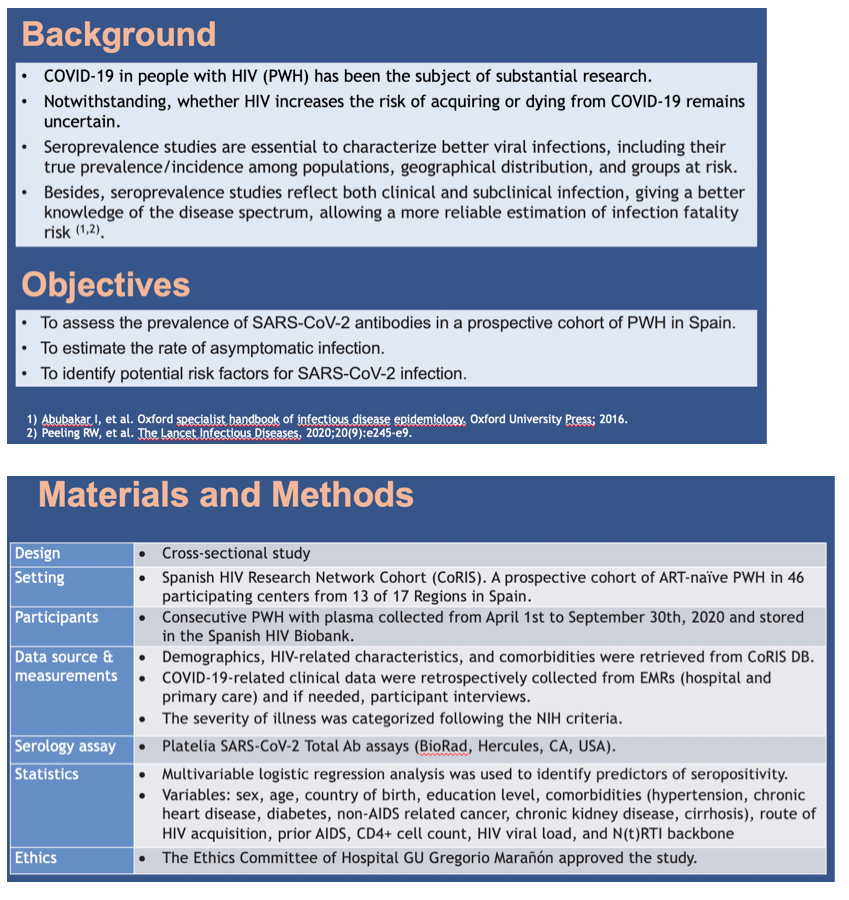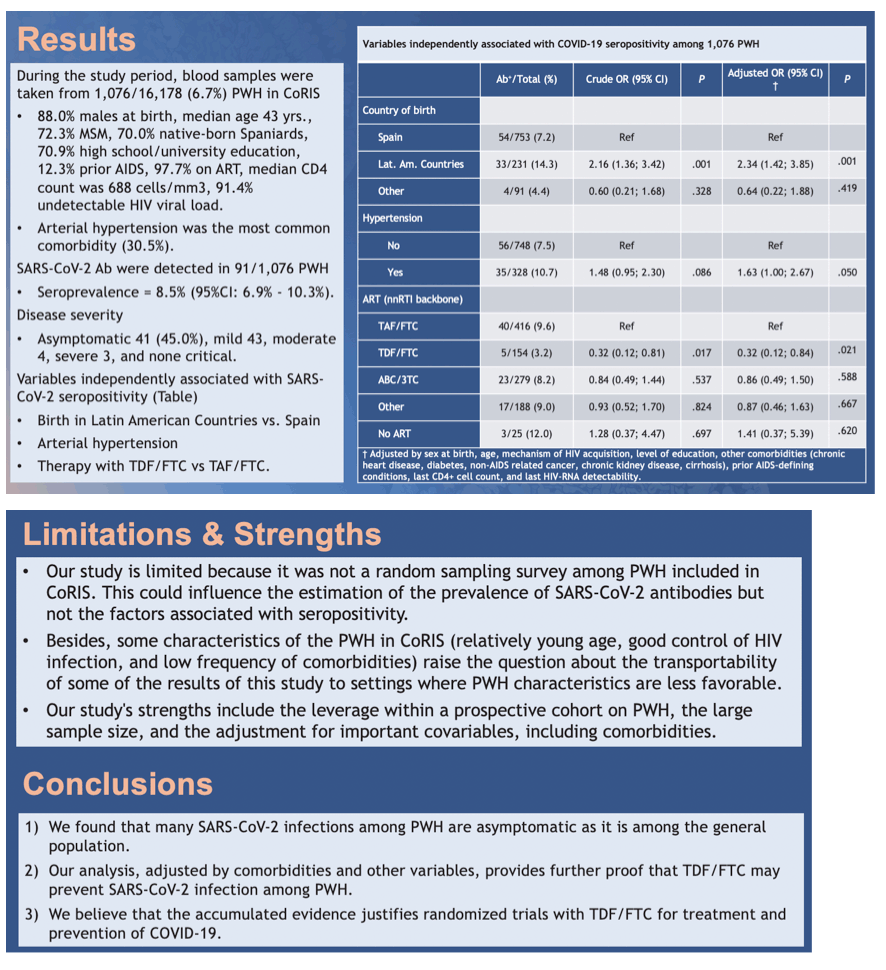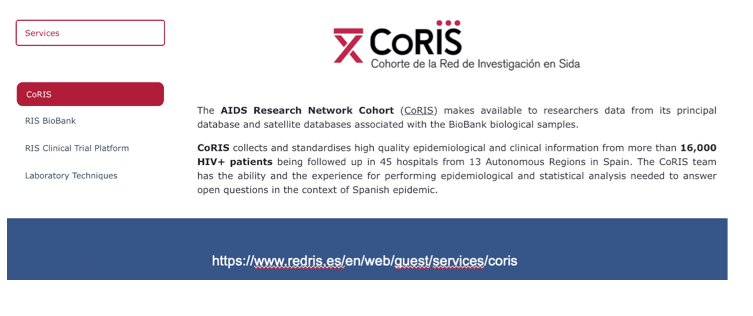 |
 |
 |
| |
PREVALENCE AND FACTORS ASSOCIATED WITH SARS-CoV-2 ANTIBODIES IN A SPANISH HIV COHORT
|
| |
| |
CROI 2021 March 6-10 Reported by Jules Levin
Juan Berenguer1, Cristina Diez1, Maria Martin-Vicente2, Rafael Mican3, Maria Jesus Perez-Elias4, Lucio Jesus F. Garcia-Fraile5, Francesc Vidal6, Ines Suarez-Garcia7, Daniel Podzamczer8, Juan C. Lopez1, Jose R. Arribas3, Santiago Moreno4, Juan Gonzalez-Garcia3, Salvador Resino2, Inmaculada Jarrin9
1Hospital General Universitario Gregorio Maranon, Madrid, Spain, 2Centro Nacional de Microbiologia, Instituto de Salud Carlos III, Majadahonda, Spain, 3La Paz University Hospital, Madrid, Spain, 4Hospital Ramon y Cajal, Madrid, Spain, 5Hospital Universitario de La Princesa, Madrid, Spain, 6Hospital Universitario de Tarragona Joan XXIII, Tarragona, Spain, 7Hospital Universitario Infanta Sofia, San Sebastian de los Reyes, Spain, 8Hospital Universitario de Bellvitge, Barcelona, Spain, 9Centro Nacional de Epidemiologia, Instituto de Salud Carlos III, Madrid, Spain
Background: Within a prospective cohort of people with HIV (PWH) in Spain, we assessed the prevalence of SARS-CoV-2 antibodies (Ab), the proportion of asymptomatic COVID-19, and identified predictors of infection.
Methods: We determined SARS-CoV-2 Ab in plasma samples collected from April 1st to September 30th, 2020, from enrollees in the Spanish HIV Research Network Cohort (CoRIS), a prospective national cohort of PWH, naive to ART at study entry, seen for the first time from January 1st, 2004. Samples were stored at -80°C in the Spanish HIV BioBank, and serology was performed using the Platelia SARS-CoV-2 Total Ab assays (BioRad, Hercules, CA, USA). Illness severity (NIH criteria) was assessed by medical records review and, if needed, participant interviews. Multivariable logistic regression analysis was used to identify predictors of seropositivity among the following variables: sex, age, country of birth, education level, comorbidities (hypertension, chronic heart disease, diabetes, non-AIDS related cancer, chronic kidney disease, cirrhosis), route of HIV acquisition, prior AIDS, CD4+ cell count, HIV viral load, and N(t)RTI backbone.
Results: During the study period, blood samples were collected and stored in the HIV BioBank from 1,076 consecutive PWH in CoRIS: 88.0% male at birth, median age 43 yr., 72.3% MSM, 97.7% on ART, median CD4+ 688 cells/mm, 91.4% undetectable HIV viral load. SARS-CoV-2 Ab were detected in 91 PWH, for a seroprevalence of 8.5% (95%CI: 6.9% - 10.3%). A total of 41 PWH (45.0%) had asymptomatic infections; the disease was mild in 43 (47.3%), moderate in 4 (4.4%), severe in 3 (3.3%), and 0 critical. Seven PWH (7.7%) were hospitalized. COVID-19 was confirmed by RT-PCR in 22 (24.2%) PWH. Variables independently associated with SARS-CoV-2 seropositivity were birth in Latin American (LA) Countries vs. Spain (adjusted odds ratio [aOR]: 2.34, 95%CI: 1.42 - 3.85; P=.001); arterial hypertension (aOR: 1.63, 95%CI: 1.00 - 2.67; P=.050); and therapy with tenofovir disoproxil fumarate plus emtricitabine (TDF/FTC) vs tenofovir alafenamide (TAF)/FTC as the N(t)RTI backbone (aOR: 0.32, 95%CI: 0.12 - 0.84; P=.021). (Table).
Conclusion: A large proportion of SARS-CoV-2 infections among PWH were asymptomatic. Birth in LA- countries and arterial hypertension were associated with increased risk of SARS-CoV-2 seropositivity. Our analysis, adjusted by comorbidities and other variables, suggest that TDF/FTC may prevent SARS-CoV- 2 infection among PWH.



|
| |
|
 |
 |
|
|